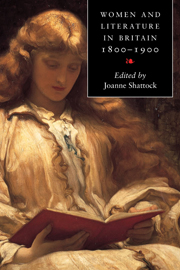Book contents
- Frontmatter
- Contents
- List of contributors
- Acknowledgments
- Chronology
- Introduction
- 1 The construction of the woman writer
- 2 Remaking the canon
- 3 Women and the consumption of print
- 4 Women writing woman: nineteenth-century representations of gender and sexuality
- 5 Feminism, journalism and public debate
- 6 Women's writing and the domestic sphere
- 7 Women, fiction and the marketplace
- 8 Women poets and the challenge of genre
- 9 Women and the theatre
- 10 Women writers and self-writing
- 11 The professionalization of women's writing: extending the canon
- 12 Women writers and religion
- 13 Women writing for children
- Guide to further reading
- Index
6 - Women's writing and the domestic sphere
Published online by Cambridge University Press: 03 October 2009
- Frontmatter
- Contents
- List of contributors
- Acknowledgments
- Chronology
- Introduction
- 1 The construction of the woman writer
- 2 Remaking the canon
- 3 Women and the consumption of print
- 4 Women writing woman: nineteenth-century representations of gender and sexuality
- 5 Feminism, journalism and public debate
- 6 Women's writing and the domestic sphere
- 7 Women, fiction and the marketplace
- 8 Women poets and the challenge of genre
- 9 Women and the theatre
- 10 Women writers and self-writing
- 11 The professionalization of women's writing: extending the canon
- 12 Women writers and religion
- 13 Women writing for children
- Guide to further reading
- Index
Summary
In the nineteenth century, middle-class women were writing both within the domestic sphere and about it, shaping through their representations the context that was simultaneously enabling and disabling their own literary efforts. Although their working-class sisters still lacked the leisure and resources that could support sustained literary efforts, bourgeois women enjoyed increasing access to the conditions and means supporting writing and publication. Indeed, writing, along with teaching, presented itself as one of the very few ways to earn money for a respectable woman. Exigency, as well as talent, led many to pick up a pen, and, although they may have chafed at forces that continued to hamper their efforts, they challenged the odds and produced wonderful literature.
If we glance ahead to the early twentieth century to take a retrospective view of the preceding century, we recognize in Virginia Woolf's violent response to that avatar of the home, the ‘Angel in the House’, forces that threatened to cripple a creative writer's talents. The woman writer suffered not only from a lack of privacy and insufficient time for concentration; at the same time her efforts were hampered by an expectation that the household Angel, the middle-class wife and mother, would sublimate all of her needs and desires in the well-being of her family. Woolf claims she had to kill her domestic predecessor to prevent her from stifling her creative energies: ‘My excuse, if I were to be had up in a court of law, would be that I acted in self-defense. Had I not killed her she would have killed me. She would have plucked the heart out of my writing.’
- Type
- Chapter
- Information
- Women and Literature in Britain 1800–1900 , pp. 119 - 141Publisher: Cambridge University PressPrint publication year: 2001
- 4
- Cited by



